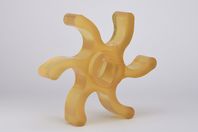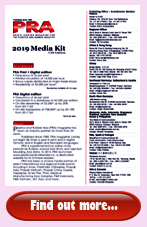PRA Chinese
Rubber Journal Asia Injection Moulding Asia Energy, Oil & Gas Asia
VISIT OUR OTHER SITES:
PRA Chinese
Rubber Journal Asia
Injection Moulding Asia
Energy, Oil & Gas Asia
K2019: Low-prepolymer PUs an alternative to rubber for star wheels

Speciality chemicals business Lanxess’s Urethane Systems business unit has developed an alternative to synthetic rubber for producing star wheels for material separation plants and material transport. It is based on polyurethane (PU) elastomers produced from Adiprene Low Free (LF) prepolymers. The German firm says the PU star wheels are not only characterised by a longer service life and mechanical performance, but are also resistant to heat and moisture.
In addition to the material, the constructive design of the star wheels also comes from Lanxess. It was developed based on product requirements, technical application and optimisation algorithms using the CAD software Solidworks. This design is licensed.
“We have already signed contracts with selected processors in North America to ensure that end customers of star wheels benefit from the highest level of quality and performance,” says Michael Timm, global head of Marketing and Development at Urethane Systems.
While the beginnings of the star wheel can be traced back to the reprocessing of old newspapers, they can now be used to separate paper from various household mixed waste (single-stream recycling). The plants used for the single-stream recycling process must be able to handle waste streams at speeds of up to 50 tonnes/hour. The star screen machines used in single stream material recycling facilitys (MRFs) each consist of several steel axles on which the star wheels are mounted.
Each deck has its own star wheel arrangement depending on the screen size. In particular, the star wheels of the first screening decks are extremely subject to abrasion because they have to sort out heavier waste components at high running speeds. “A wheel version based on our Adiprene LF TDI prepolymer is used in the plants, which is twice as durable as a component made of rubber. The wheels can therefore be replaced less frequently, which saves material costs and extends the maintenance intervals of the plants,” says Timm. The extreme wear resistance of the wheels is due to the high abrasion, tear and cut resistance of the PU elastomer.
Adiprene LF TDI is based on LF technology, which reduces the content of free TDI isocyanate (toluene diisocyanate) in the prepolymer to below 0.1%. Lanxess says it meets the highest ecological and industrial hygiene standards, allowing the processor to use the minimum amount of protective measures.
Advantages also arise during processing. According to Timm, “The long pot life and low viscosities of the Adiprene LF prepolymer system allow controlled processing without the use of solvents. The viscosity can be controlled and specifically adapted to the application. In addition, the PU components are easy to demold, benefiting high productivity with minimal waste.”
The use of Adiprene LF TDI is not limited to star wheels for waste recovery and recycling facilities. “We believe that the PU star wheels can also be used in agriculture, for example in harvesting systems or for handling mulch, peat, humus and compost,” explains Timm. Further application opportunities arise in the construction industry, including in the demolition of buildings, in forestry and in extremely fast production processes for food, beverages and health products.
(PRA)Subscribe to Get the Latest Updates from PRA Please click here
©2018 Plastics and Rubber Asia. All rights reserved.

©2018 Plastics and Rubber Asia. All rights reserved.
Home Terms & Conditions Privacy Policy Webmail Site Map About Us




















